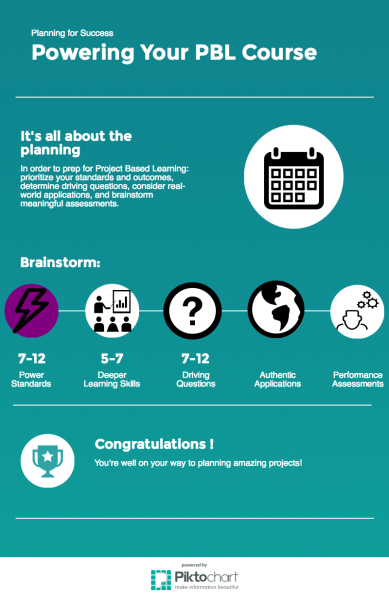This blog post is part one of a series designed to support you as you plan for an upcoming school-year dedicated to deeper learning for your students via Project Based Learning. Many thanks to Drew Schrader for collaboration on this series, which is cross-posted on his awesome blog Learning Habit. Thanks to Erica Snyder at Teaching Channel for all her help with these posts as well. You can check out her work here. You can find the other posts in the series here:
- Part Two: Deeper Learning Skills
- Part Three: Driving Questions
- Part Four: Authentic Applications
- Part Five: Performance Assessments
- You can also find a template for keeping track of your thinking here.
Powering Your PBL Course: Power Standards
Seasoned teachers know, whether they say it out loud or not, that teaching any course requires making hard choices about what material is most worthy of time and attention. Often this question of “depth vs coverage” comes up as a “known challenge of PBL,” but in fact it is keenly present for any teacher who spends even a moment concerned with what students are learning as opposed to simply what has been taught.
 Making the move to PBL does press this issue however. One of the the most regular comments we hear at new teacher PBL workshops is, “the content will stay the same, it is just the method of delivery that will change.” Often this comes near the end of the training, and as trainers we interpret it as a positive sign that teachers are seeing how taking on a project-based approach leaves room for, and in fact necessitates, that they make use of the best of their previous teaching and learning practices. This latter part is emphatically true. But I want to let you in on a dirty secret: the content changes too.
Making the move to PBL does press this issue however. One of the the most regular comments we hear at new teacher PBL workshops is, “the content will stay the same, it is just the method of delivery that will change.” Often this comes near the end of the training, and as trainers we interpret it as a positive sign that teachers are seeing how taking on a project-based approach leaves room for, and in fact necessitates, that they make use of the best of their previous teaching and learning practices. This latter part is emphatically true. But I want to let you in on a dirty secret: the content changes too.
This is the best kind of dirty secret however, the kind that feels like you are cheating, getting away with something, though in truth it is something teachers should have had permission for all along. Much of our current educational practice is built on the mistaken assumption that our task is to eliminate ignorance, that students can learn everything of importance by the time they graduate compulsory schooling.
The late educational thinker and gadfly Grant Wiggins noted:
Until we accept the sometimes tragic, sometimes comic, view that students, by definition, are ill-equipped at the end of their tutelage for all that their professions and intellectual lives will require, we will keep miseducating them. Curriculum design could then be finally liberated from the sham of the typical scope and sequence whereby it is assumed that a logical outline of all adult knowledge is translatable into complete lessons and where a fact or theory encountered once in 8th grade as a spoken truism is somehow to be recalled and intelligently used in the 11th.
If we embrace the insight above that coverage based on exposing students to an organized outline of adult understanding in a discipline does not magically deposit that knowledge into students brains for further use even a few years later, then we can take up the more useful task of intentionally prioritizing our learning goals. Identifying power standards is a well-established process for this prioritization.This is the first step towards crafting an impactful PBL curriculum.
In his book Focus, Michael Schmoker cites other education notables like Hattie, Marzano, and Ainsworth as promoting the idea of developing a manageable number of power standards as the key reference points for curriculum design. These power standards “must not be excessive; it should account for about half of what is contained in our standards documents.” The point Schmoker and others make is that embracing the need to prioritize critical material for your curriculum allows you to prevent Wiggins’ “shame of traditional scope and sequence” and instead develop a reasonable curriculum. If you are picking up the potentially excessive “name dropping,” it is intentional. Part of what we want to dispel is the myth that PBL causes this challenge around content coverage. In reality, most of the leading voices in curriculum and instruction design argue for the same thing, without any assumptions about methodology.
It is also worth remembering that curriculum standards, even those that have been “modernized” with an eye towards a more coherent core of content, are still written by subject area experts who, by virtue and vice of their expertise, are deeply fluent in the nuances of their content. These nuances make standards marvelous references for close reading and reflection on the contours of disciplinary knowledge, and also inappropriate if taken together for the goals for a course.
So how do you do it?
Douglas Reeves recommends a 3-part test as you review your various sources including state and national standards, district and department curriculum maps, the NTN Outcome Rubrics, professional standards for your field, etc:
- Endurance – will this standard or indicator provide students with knowledge and skills of value beyond a single test date?
- Leverage – will this provide knowledge and skills that will be of value in multiple disciplines?
- Readiness – will this provide students with essential knowledge and skills that are necessary for success in the next grade or the next level of instruction?
In addition to the above criteria, here are a few general tips for the creation of Power Standards:
- Shoot for a manageable number (7-12) and assume these might form the basis for your driving questions and project topics. Elementary teachers will likely need to repeat this process multiple times for each of the core areas they are responsible for.
- Feel free to write your own language for the power standards, considering them a synthesis of your sources.
- Consider the test! While much of what we are discussing is invitation to think beyond “covering standards so kids can pass a low-level test” it would be foolish not to anchor your project-based curriculum in the types of standards and skills your state or national test prioritizes.
- Work with colleagues. If you are fortunate enough to have an integrated course and a co-teacher, coming together around your power standards and looking for the best areas of overlap is a great place to begin your collaboration. If you are working with a full department or grade-level team, you might consider using a formal protocol to identify power standards as a group.
- Swap notes – especially if you are new. As you start to put your notes together – perhaps in a handy template – look for opportunities to share your thinking with colleagues. New teachers in particular might benefit from comparing their set of prioritizations, and the rationale behind that, with more seasoned colleagues.
- Assume in advance that you won’t have it perfect and that you don’t need to. Bringing this level of intentionality to your planning should allow you to move forward into your first year of PBL with confidence. Committing to revisiting this map throughout the year and refining each year as you go is the route to getting closer each year.

[…] Part One: Power Standards […]
To identify the 5 power standards I need to remember to consider 3 things. How will Endurance, Leverage, and Readiness be applied to each standard?
[…] Part One: Power Standards […]
[…] Part One: Power Standards […]
I can see how the three part test and the NTN outcome rubrics can help you choose your power standards but as a first year NTN teacher how will I know that I am making the best decisions for my students?
Great question! It’s always challenging to answer, I think, but especially in your first year when it’s hard to imagine the full scope of the year. I’d definitely encourage you to consider your power standards a first draft, knowing you can return to them based on your student’s needs and how the year goes. I’d also encourage you to continue the conversation with other teachers.
I like the 3-part test. This will come in handy when working with new teachers!